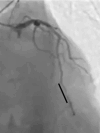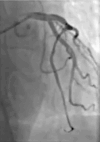MYOCARDIAL BRIDGE STENTING COMPLICATED BY CORONARY ARTERY PERFORATION AND MIDLAD-RIGHT VENTRICLE FISTULA FORMATION IN NSTEMI PATIENT
- PMID: 40599473
- PMCID: PMC12207853
- DOI: 10.20471/acc.2024.63.s1.10
MYOCARDIAL BRIDGE STENTING COMPLICATED BY CORONARY ARTERY PERFORATION AND MIDLAD-RIGHT VENTRICLE FISTULA FORMATION IN NSTEMI PATIENT
Abstract
We report a case of a patient who presented with non ST-elevation myocardial infarction and coronary angiography showing a long myocardial bridge (MB) of the left anterior descending artery (LAD) with a fixed significant stenosis at the entry point of the MB. The lesion was treated with a semi-compliant balloon and drug-eluted stent (DES). After the stent placement, a large arterial perforation with fistula to right ventricle was observed. There was no hemodynamic instability due to the fistula progression during the procedure and the perforation point was successfully closed with a stent-graft. Additionally, we provide a short review of diagnostic and therapeutic approach to MB stenting and reports of cases with coronary artery perforation after stenting of MB.
Keywords: bridging; coronary intervention; perforation; stent.
Sestre Milosrdnice University Hospital.
Figures
Similar articles
-
Drug-eluting stents versus bare-metal stents for acute coronary syndrome.Cochrane Database Syst Rev. 2017 Aug 23;8(8):CD012481. doi: 10.1002/14651858.CD012481.pub2. Cochrane Database Syst Rev. 2017. PMID: 28832903 Free PMC article.
-
Percutaneous management of coronary artery fistula in acute coronary syndrome using a covered stent crush technique: a case report.BMC Cardiovasc Disord. 2025 Jul 28;25(1):549. doi: 10.1186/s12872-025-05059-y. BMC Cardiovasc Disord. 2025. PMID: 40722050 Free PMC article.
-
Stenting a myocardial bridge: a wrong decision in STEMI?Acta Cardiol. 2011 Feb;66(1):89-91. doi: 10.1080/ac.66.1.2064974. Acta Cardiol. 2011. PMID: 21446388
-
Coronary artery stents: a rapid systematic review and economic evaluation.Health Technol Assess. 2004 Sep;8(35):iii-iv, 1-242. doi: 10.3310/hta8350. Health Technol Assess. 2004. PMID: 15361315
-
Successful management of a calcified coronary nodule with intravenous lithotripsy: a case report and review of literature.J Med Case Rep. 2025 Jun 18;19(1):282. doi: 10.1186/s13256-025-05341-9. J Med Case Rep. 2025. PMID: 40533839 Free PMC article. Review.
References
-
- Hwang HJ, Park CB, Cho JM, Jin ES, Sohn IS, Kim DH, et al. Clinical characteristics of occluded culprit arteries and collaterals in patients with non-ST-segment elevation myocardial infarction and impact on clinical outcomes. Exp Ther Med. 2018. October;16(4):3710–20. 10.3892/etm.2018.6605 - DOI - PMC - PubMed
-
- Fiorani B, Capuano F, Bilotta F, Guccione F, Santaniello E, Sinatra R, et al. Myocardial bridging in hypertrophic cardiomyopathy: a plea for surgical correction. Ital Heart J. 2005. November;6(11):922–4. - PubMed
Publication types
MeSH terms
LinkOut - more resources
Full Text Sources
Medical
Miscellaneous




